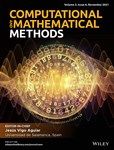Solving fully randomized higher-order linear control differential equations: Application to study the dynamics of an oscillator
Funding information: European Social Fund, GJIDI/2018/A/009; GJIDI/2018/A/010; Spanish Ministerio de Economía, Industria y Competitividad (MINECO), the Agencia Estatal de Investigación (AEI) and Fondo Europeo de Desarrollo Regional (FEDER UE), MTM2017-89664-P
Abstract
In this work, we consider control problems represented by a linear differential equation assuming that all the coefficients are random variables and with an additive control that is a stochastic process. Specifically, we will work with controllable problems in which the initial condition and the final target are random variables. The probability density function of the solution and the control has been calculated. The theoretical results have been applied to study, from a probabilistic standpoint, a damped oscillator.
1 INTRODUCTION
Theorem 1. (RVT technique [[9], pp 24–25])Let and be two m-dimensional absolutely continuous random vectors defined on a complete probability space . Let be a one-to-one deterministic transformation of into , that is, , . Assume that s is a continuous mapping and has continuous partial derivatives with respect to each component xi, 1 ≤ i ≤ m. Then, if fx(x1, … , xm) denotes the joint PDF of the vector , and p = s−1 = (p1(z1, … , zm), … , pm(z1, … , zm)) represents the inverse mapping of s = (s1(x1, … , xm), … , sm(x1, … , xm)), the joint PDF of the random vector is given by
We finish this section pointing out that throughout this article the exponential function will be denoted by e or , interchangeably.
2 CONTROLLABLE RANDOMIZED EQUATION
Details about how is derived Equation (13) can be found in recent literature, for example, Lazar and Zuazua12 or Section 3 of Cortés et al.10
As problem (7)–(11) is controllable for all and 0 < t < T, using Remark 1 of Cortés et al.,10 we can establish the following results that will play a fundamental role in Sections 3.1 and 3.2.
Remark 1. defined by expression (15), where is defined by (9) is an invertible matrix for and t ∈]0, T].
Remark 2.As a consequence of Remark 1, is well defined. Also, and are invertible matrices for and t ∈]0, T].
3 COMPUTATION OF THE 1-PDF OF SOME STOCHASTIC PROCESSES OF INTEREST IN CONTROL PROBLEMS
Also, and for the sake of generality, we will assume a joint PDF for these 3n RVs that will be denoted by .
3.1 Computing the 1-PDF of the solution SP
In this section, we will determine the 1-PDF, f1(y, t), of the solution SP, , of problem (7)–(11). Notice that involves the solution SP, , of problem (4) and their derivatives until order n − 1. Then, the 1-PDF associated to is a joint PDF that provides relevant information about and their derivatives.
3.2 Computing the 1-PDF of the control SP
The 1-PDF of is determined by applying Theorem 1 in a similar way to the one developed in Section 3.1.
4 APPLICATION TO STUDY THE DYNAMICS OF A RANDOM OSCILLATOR
-
- Case 1
-
- In this case, we choose the constant values k = 10 and R = 1.
-
- Case 2
-
The following distributions are considered:
-
has a truncated normal distribution of parameters and on the interval [9, 11].
- has a truncated normal distribution of parameters and on the interval [0.5, 1.5].
Observe that the mean of and coincide with the ones assumed in Case 1.
In Figure 1, we have represented the joint 1-PDF of the solution SP of system (27) at t = 0.2 in Cases 1 (top) and 2 (bottom). We can observe that the analytical computations obtained applying RVT method developed in this article agree with Monte Carlo simulations and that the 1-PDF is flattened in the presence of randomness in the model parameters. Similar behavior can be observed considering other times. This issue is better observed in Figure 2, where we have represented the phase portrait. The expectation of the SP solution follows the shape of a spiral line, being represented by a discontinuous curve. This expectation is shown with a pink point at the following times, t = {0, 0.2, 0.4, 0.5, 0.6, 0.9, 1}. Also, at this specific times, confidence regions at 50% and 90% level are plotted in blue and red lines, respectively.
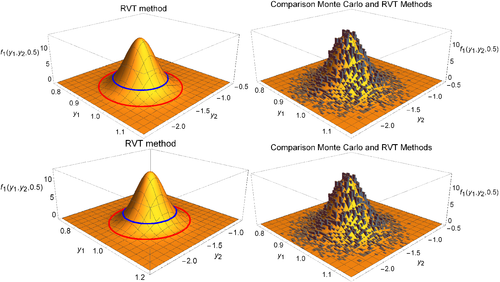
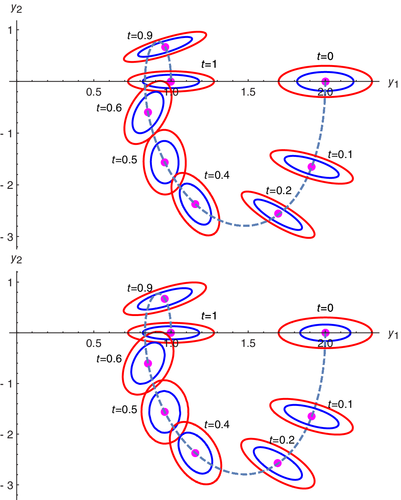
The 1-PDF of control SP, , for Cases 1 and 2 is shown in Figure 3 at times t = {0, 0.1, 0.5, 0.8, 1}, top and bottom, respectively. We can observe that in both cases it is sharper specially at initial and final times. Notice that the 1-PDFs for a fixed time are more similar when we are at intermediate times.
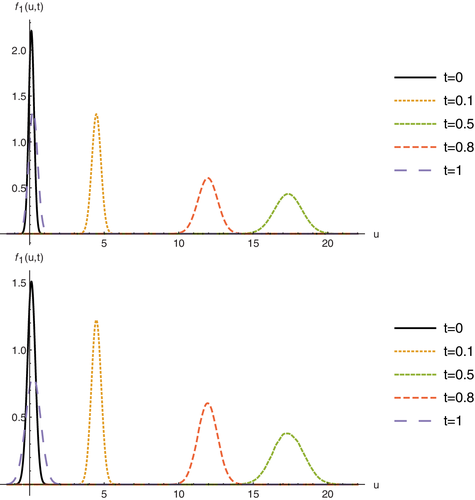
In Figure 4, we have plotted the 1-PDF, f1(x, t), of the solution SP, of problem (26), at several times instants in both Cases 1 and 2. Also, the mean has been plotted with red and dashed lines in both cases. Notice that in Case 1 the PDFs are sharper at intermediate times.
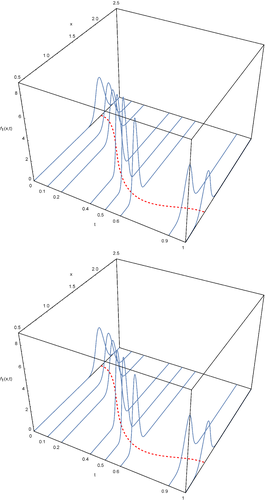
5 CONCLUSIONS
In this article, the PDF of a controllable linear system with additive control has been calculated, as well as the PDF of the control in the case that all the coefficients, initial condition and final target are RVs, and the control is a SP. The obtained theoretical results have been applied to study a random damped oscillator. It has been found that by adding more randomness to model parameters, the variability of the solution increases. The results have been validated with Monte Carlo simulations. The equation becomes a system where some of the elements of matrix A are random, which is a novelty with respect to previous works.10 This is a first step to treat systems in the future where all the elements of A and B are RVs.
ACKNOWLEDGMENTS
This work has been supported by the Spanish Ministerio de Economía, Industria y Competitividad (MINECO), the Agencia Estatal de Investigación (AEI), and Fondo Europeo de Desarrollo Regional (FEDER UE) grant MTM2017-89664-P. Computations have been carried thanks to the collaboration of Raúl San Julián Garcés and Elena López Navarro granted by European Union through the Operational Program of the European Regional Development Fund (ERDF)/European Social Fund (ESF) of the Valencian Community 2014–2020, grants GJIDI/2018/A/009 and GJIDI/2018/A/010, respectively.
CONFLICT OF INTEREST
The authors declare that there is no conflict of interests regarding the publication of this article.
AUTHOR CONTRIBUTIONS
All authors have equally contributed to the whole article.
APPENDIX A: CONSTRUCTION OF THE 1-PDFS IN THE CONTEXT OF THE APPLICATION
In this appendix, we detail how to construct the closed form of both the joint 1-PDF of the solution SP, f1(y, t), and the 1-PDF of the control SP, f1(u, t). As in the application we have considered two cases, we obtain the formulas in each scenario.
A.1 Case 1
A.2 Case 2
Biographies

Juan-Carlos Cortés is a Full Professor of Applied Mathematics at Universitat Politècnica de València (UPV). He develops his research in Mathematical Modeling with Uncertainty in the Instituto Universitario de Matemática Multidisciplinar at the UPV.

Ana Navarro-Quiles is an Assistant Professor at Universitat de València. Her research focuses on the study, from a probabilistic point of view, of random differential equations as well as their applications.

José-Vicente Romero is an Associate Professor of Applied Mathematics at Universitat Politècnica de València (UPV). His investigation deals with Stochastic Problems and Applications in the Instituto Universitario de Matemática Multidisciplinar at the UPV.

María-Dolores Roselló is an Associate Professor of Applied Mathematics at Universitat Politècnica de València (UPV). Her research focuses on Random Systems and Applications in the Instituto Universitario de Matemática Multidisciplinar at the UPV.



